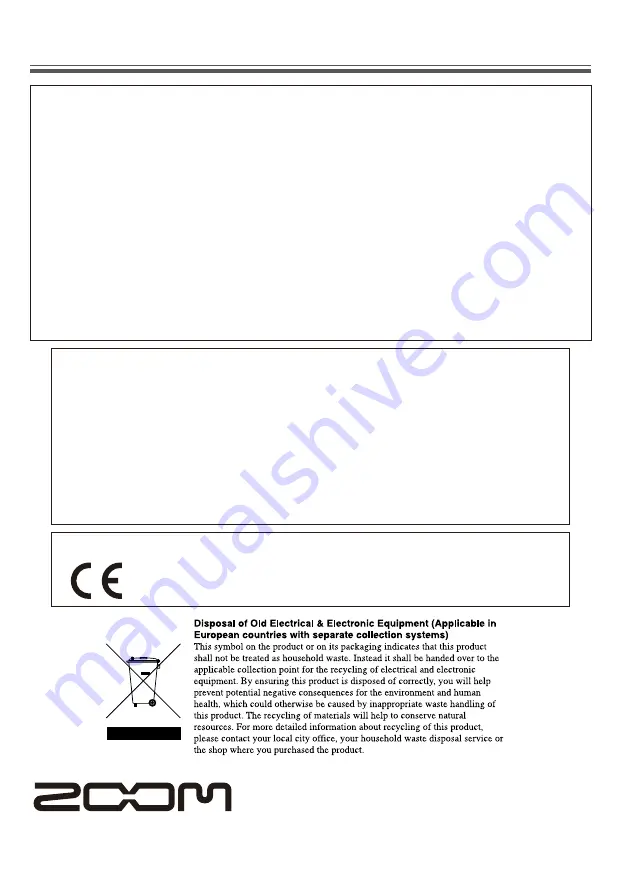
ZOOM CORPORATION
4-4-3, Kandasurugadai, Chiyoda-ku, Tokyo 101-0062, Japan
Web Site: http://www.zoom.co.jp
G1u - 5000-4
Specifications
Effect types
67
Effect modules
max. 8 simultaneous modules
Patch memory
User banks: 10 patches x 10 banks = 100
Preset banks: 10 patches x 10 banks = 100
Total 200 patches
Sampling frequency
96 kHz
A/D converter
24 bit 64 times oversampling
D/A converter
24 bit 128 times oversampling
Signal processing
32 bit
Frequency response
20 Hz – 40 kHz +1.0 dB
-4.0 dB (10-kilohm load)
Display
2-digit 7-segment LED
Input
Standard mono phone jack
Rated input level
-20 dBm
Input impedance
470 kilohms
Output
Standard stereo phone jack
(doubles as line/headphone jack)
Maximum output level
Line +3 dBm (output load impedance of 10
kilohms or more)
Phones 20 mW + 20 mW (into 32-ohm
load)
Control input
For FP01/FP02 or FS01
USB interface
16-bit PC interface (one line each for stereo
record/play)
Sampling frequencies
32 kHz, 44.1 kHz, 48 kHz
Power requirements
AC adapter
9 V DC, 300 mA (center minus plug)
(ZOOM AD-0006)
Batteries
Four IEC R6 (size AA) batteries, approx. 10
hours continuous operation (alkaline
batteries)
USB bus power
Dimensions
155 mm (D) x 136 mm (W) x 52 mm (H)
Weight
350 g (without batteries)
Options
Expression pedal
FP01/FP02 or Foot switch FS01
The FCC regulation warning (for U.S.A.)
This equipment has been tested and found to comply with the limits for a Class B digital device, pursuant to Part 15 of
the FCC Rules. These limits are designed to provide reasonable protection against harmful interference in a residential
installation. This equipment generates, uses, and can radiate radio frequency energy and, if not installed and used in
accordance with the instructions, may cause harmful interference to radio communications. However, there is no
guarantee that interference will not occur in a particular installation. If this equipment does cause harmful interference
to radio or television reception, which can be determined by turning the equipment off and on, the user is encouraged
to try to correct the interference by one or more of the following measures:
• Reorient or relocate the receiving antenna.
• Increase the separation between the equipment and receiver.
• Connect the equipment into an outlet on a circuit different from that to which the receiver is connected.
• Consult the dealer or an experienced radio/TV technician for help.
For EU Countries
Declaration of Conformity:
This product complies with the requirements of EMC Directive 2004/108/EG and Low
Voltage Directive 2006/95/EC





















